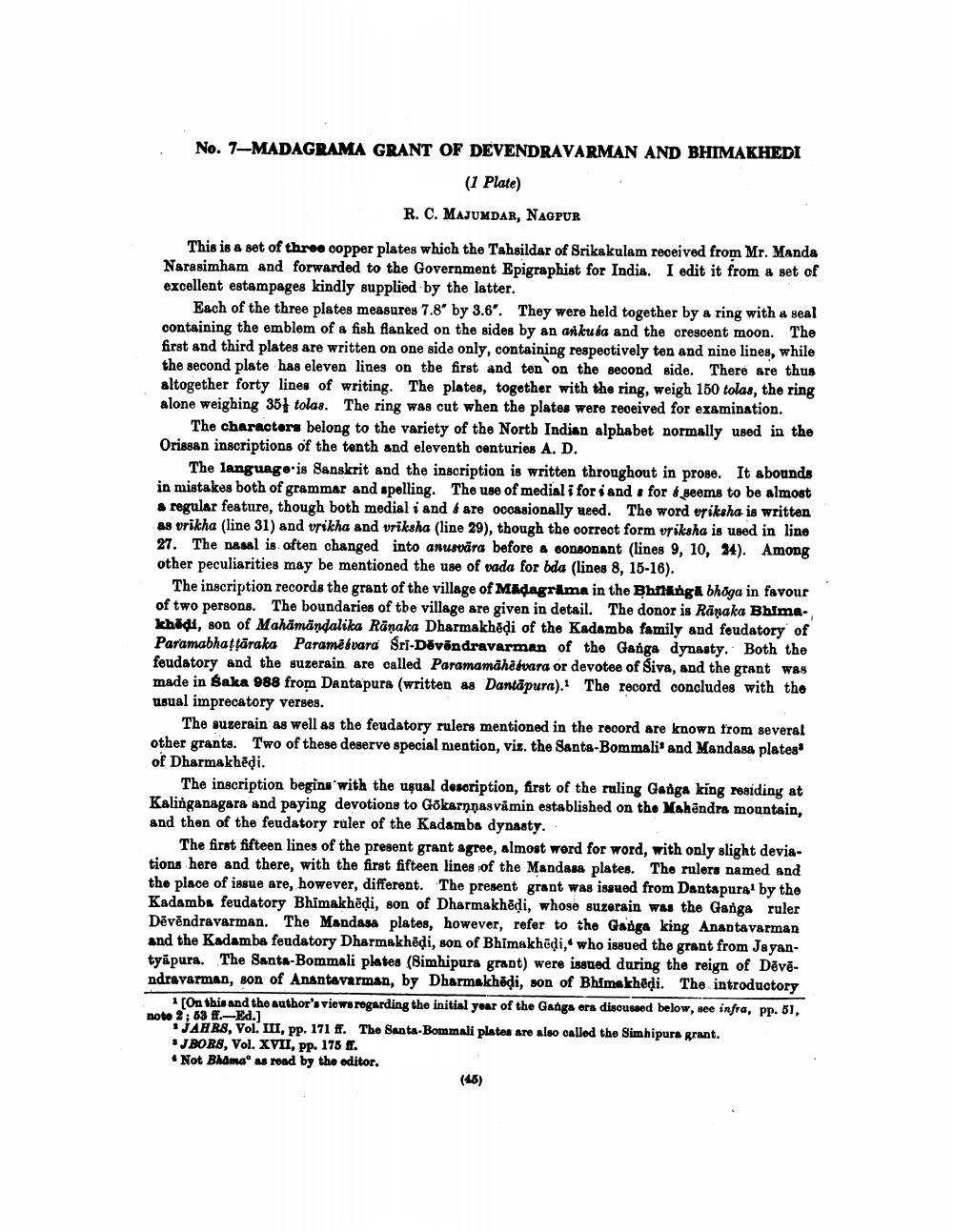________________
No. 7-MADAGRAMA GRANT OF DEVENDRAVARMAN AND BHIMAKHEDI
(1 Plate) R. C. MAJUMDAR, NAGPUR
This is a set of throo oopper plates which the Tahsildar of Srikakulam received from Mr. Manda Narasimham and forwarded to the Government Epigraphist for India. I edit it from a set of excellent estampages kindly supplied by the latter.
Each of the three plates measures 7.8' by 3.6'. They were held together by a ring with a seal containing the emblem of a fish flanked on the sides by an ankusa and the crescent moon. The first and third plates are written on one side only, containing respectively ten and nine lines, while the second plate has eleven lines on the first and ten on the second side. There are thus altogether forty lines of writing. The plates, together with the ring, weigh 150 tolas, the ring alone weighing 354 tolas. The ring was cut when the plates were received for examination.
The characters belong to the variety of the North Indian alphabet normally used in the Orissan inscriptions of the tenth and eleventh centuries A. D.
The language is Sanskrit and the inscription is written throughout in proge. It abounds in mistakes both of grammar and spelling. The use of medial i for i and for seems to be almost a regular feature, though both medial i and 6 are occasionally ueed. The word uriksha is written as vrikha (line 31) and vrikha and vriksha (line 29), though the correct form vriksha is used in line 27. The nasal is often changed into anusvāra before a consonant (lines 9, 10, 34). Among other peculiarities may be mentioned the use of vada for bda (lines 8, 15-16).
The inscription records the grant of the village of Madagrima in the Bhninga bhoga in favour of two persons. The boundaries of the village are given in detail. The donor is Ränaka Bhimakhidi, son of Mahämändalika Ränaka Dharmakhēdi of the Kadamba family and feudatory of Paramabhattāraka Parametvara Sri-Dövöndravarman of the Ganga dynasty. Both the feudatory and the suzerain are called Paramamähetvara or devotee of Siva, and the grant was made in Saka 988 from Dantapura (written as Dantapura). The record concludes with the usual imprecatory verses.
The suzerain as well as the feudatory rulers mentioned in the record are known from several other grants. Two of these deserve special mention, viz. the Santa-Bommali' and Mandasa plates of Dharmakhēdi.
The inscription begins with the ugual description, first of the ruling Ganga king residing at Kalinganagara and paying devotions to Gokarnnas vamin established on the Malandra mountain, and then of the feudatory ruler of the Kadamba dynasty.
The first fifteen lines of the present grant agree, almost werd for word, with only slight deviations here and there, with the first fifteen lines of the Mandasa plates. The rulers named and the place of issue are, however, different. The present grant was issued from Dantapura' by the Kadamba feudatory Bhimakhēdi, son of Dharmakhēdi, whose suzerain was the Ganga ruler Dēvēndravarman. The Mandasa plates, however, refer to the Ganga king Anantavarman and the Kadamba feudatory Dharmakhedi, son of Bhimakhodi, who issued the grant from Jayantyapura. The Santa-Bommali plates (Simhipura grant) were issued during the reign of Dēvēndravarman, son of Anantavarman, by Dharmakhödi, son of Bhimakhēņi. The introductory
[On this and the author's views regarding the initial year of the Ganga era discussed below, see infra, pp. 51, note 2: 63 f.-Ed.]
1 JAHR8, Vol. III, pp. 171 ff. The Santa-Bommali plates are also called the Simhipura grant. *JBOR8, Vol. XVII, pp. 176 fr. • Not Bhama as read by the editor.
(45)




